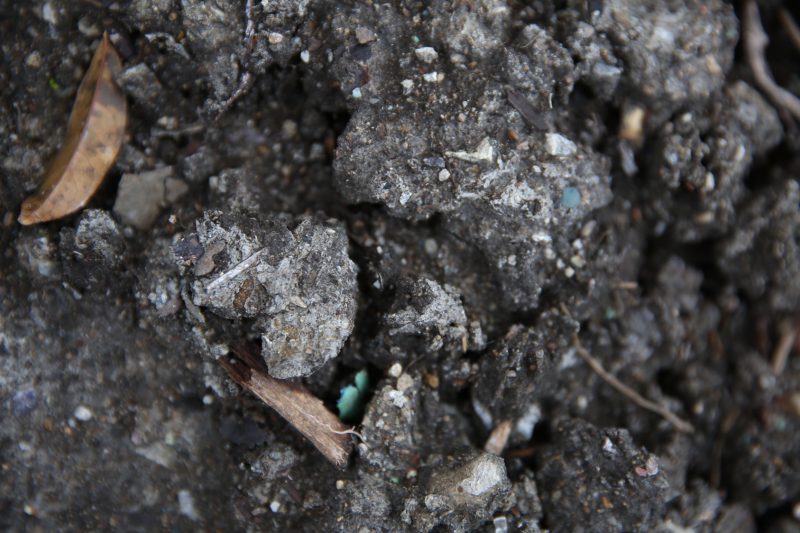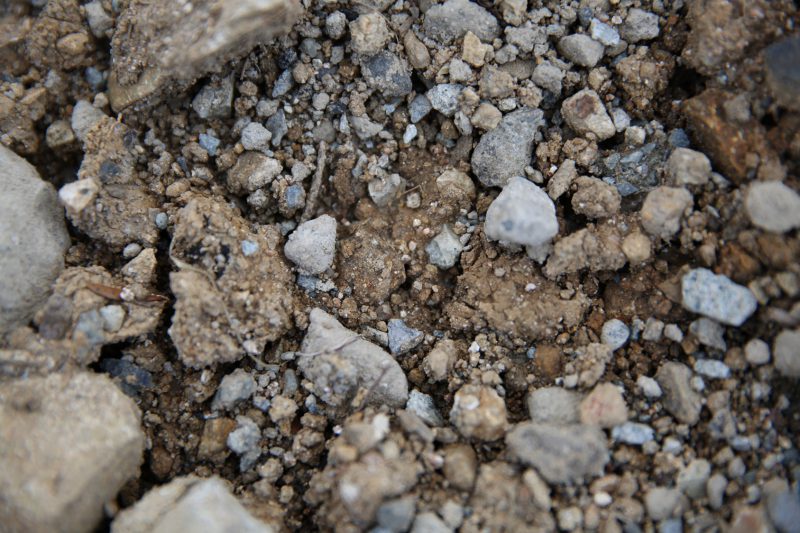niime 百科
Encyclopedia of niime
泥で染める。
Dyeing with Mud

2019 . 03 . 15
「“ベンガラ染”ってあるじゃないですか?」
開口一番玉木はそう言って、tamaki niimeならではのモノづくりの、新たな試みを語り出した。
「ベンガラ」とは土から取れる成分(酸化鉄)の事で紅殻、弁柄とも呼ばれる。日本でも古くから暮らしの中で使われて来た天然素材で赤色の顔料。江戸時代にインドのベンガル地方産のものを輸入したのでこの名が付いたそうだ。無毒で人の身体に安全という利点もある。
玉木「ベンガラ自体はもともとは神社だとか家屋の木材の腐敗を防ぐために、赤く塗装したりするもので、その塗料の産地が大阪の羽曳野市にあるんですけど、現在ではそんなに木造の寺社を建てなくなってきたし、木材自体にも腐敗防止にベンガラを塗るということをしなくなったから産地が崩壊して行きそうになった時に、今やってる人たちが何とかして生き残りをかけて考えなきゃと思ったらしくて。顔料だから本来、木や器に使うってことしかして来なかったのを、布を染色出来るんじゃないかと考えて、その為に顔料を色々と変化させたり試したらしくて。自分たちが持っている技術を使って布を染めるための顔料を開発したという。そうして布用顔料が完成して、それを販売してるんですが、自分たちで実際に染めて、ワークショップとかしてこんな風に出来ますよってゆうのを色々と打ち出しておられて。何年か前から紹介して頂いてて、お会いした事もあったんですけど、その当時はまだ天然で量産は手間もコストも難しいと思っていた時期で。」
― 草木染めは岡山で去年良い出会いがあったんですよね。
玉木「うん。それでベンガラって結局、材料が泥だから、いまウチで「大地の再生講座」をやってて、土だ!とか言い始めたでしょう?だからベンガラというのも繋がって、ちょっと一度行ってみようとなって、つい最近、お話させてほしいと羽曳野まで行って来たの。その辺りは昔からの産地だったらしくてたくさんのベンガラの顔料屋さんがいたんだけど今はもう他にはひとつも無いよと仰ってたんですけど。」
― その方はもうかなりの御高齢なんですか?
玉木「50代後半くらいかな?」
― 最後に残ってる顔料屋さんで?
玉木「そうだね。息子さんがいるけど。今ではもう無いよこの業界、僕らしか残ってないしとか言ってはって。じゃあ何で布に塗るって発想になったのって訊いたら、この技術は面白いと思ったと。色んな泥を熱して配合で色を作ってるんですって。ピンクの顔料や黄色のや色々とあるんですけど、天然のものを全部自分たちでブレンドして作ってる。もちろん含有量とかも調べたりデータも取ってるそうだけれども、もう本当に感覚で観て、自分たちの手でいちいち熱して冷まして顔料を混ぜてブレンドするってゆう、昔ながらのやり方だから、大量生産は出来ません、って言われた。」
― 儲かる・儲からない以前にベンガラの面白さに魅了されて、何とかして続けていきたいという事なのでしょうね。
玉木「着物文化で草木染めだった時代が終わり、この100年くらいの間に化学染料を使って大量生産で染めるようになっちゃったでしょう?手織りも一瞬にして廃れて。手織りがあった頃はハッピや暖簾を草木染めで染める文化も残ってたんだけど、工業製品ってなった時に、その技術ってゆうのは使い物にならないと捨てられたんだって。藍染は少し残ったかもしれないけど。播州織もそうだけど化学染料は効率的にキレイに染まると使われていったからその技術は一気に進化したけど、そんな流れの中でベンガラってゆうのは、めっちゃ手間で大量には出来へんってところで切り捨てられちゃったから、今、工業製品でベンガラ染めのものってかなり少ないって言ってた。彼らが取り組んでいるもの以外は。」
― そうなんですね…。
玉木「なんでメジャーにならなかったのか?っていうと、顔料を大量に作れないからなり得ない。って事は製造コストも下がらないし。でも化学染料で染めるよりも顔料染めの方が染めるのはラクなんです。熱は要らないし水に混ぜるだけなんですよ。漬けて絞るだけだから、なんでこんな簡単なことが、織物業界に導入されなかったかが疑問でならなかったの。お話聞いてそれくらいすごく画期的だと思ったから。だけど顔料は沢山作れず大量生産出来ないからと、同じ土俵で比較検討すらされてないじゃない?すごく簡単な染め方なのにも関わらず。だからチャンスがなかっただけで、私たちが求める天然で、より染め易く、面白い染めが出来て、しかも太陽堅牢度(※太陽光で色褪せしにくい度合い)が高いんですよ。だからスゲーじゃんこいつは!って思って。なんでもっと早くに出会わなかったんだろう、みたいな。」
― 需要が高まれば、生産者が増え産地が復活する可能性もありますね。
玉木「だから今ジワジワと、一般市民の間では顔料が復活して来ていて海外にも卸しが始まってるんですって。実際に取り引きが増えていってるらしくて良いことだなと。」
― そんな風に良い傾向が出て来たんですね。
玉木「面白いなと思って。なんてゆうの、まだまだ気づいてない、見逃している良い技術ってあるんだろうなと思って。これまで私は染料って世界しか注目して来なかったけど、あ、顔料もアリなんだ!と思った瞬間に、また世界が広がっちゃって。」
― また眠れなくなったと。
玉木「そうなの!!」
― (笑)。
玉木「ヤバイ、楽しみ!と思って。知ってはいたけど顔料を今までやらなかった理由は、布を染めると固くなるの。顔料が上に乗っかるから。だから私の求めるものとは違うと切り捨ててきたんだけど、糸の段階で顔料を使って染めるとそんなに変わらないと分かったの。シガシガした固さもないし、マットな感じに仕上がるから、私の好きな感じだったんですよね。」
― “先染め”なら使えると。
玉木「使える。だから、やった!と思って。」
― なるほど。
玉木「乞うご期待ですよ。ウチで染めてみようとベンガラ買って来たから。」
― そう考えると、地球のことを考えながらモノづくりの過程のひとつひとつを検証してゆくと、おのずとそういう貴重な技術に行き当たる感じですね。それでまた可能性が広がる。
玉木「そうなの。だから彼らのワークショップでは、訪問先の土地の泥を集めて、顔料に変えて染めましょうという事をやったりするの。」
― それは面白そうですね。
玉木「そのワークショップをウチでやってもらおうって話をしてるの。それが「大地」と、自分たちが実際に身に付けているものとを繋げるツールになると思うし。面白い!って思って。そうゆうベンガラの普及活動もしてるんです、泥は自分のところでも取れますよって言われて、あっ!そうか!ってなって。」
― それはその土地によって土の色が違ってくるという話ですか?
玉木「うん、違う。まあ日本の場合は相対的に田んぼが多くて、黒かグレーなんだそうだけど。でもオーストリアは鉄分が多いから真っ赤になるとか。そうか、土なんだ!と。それが私たちが今「大地の再生」に取り組んでいることと繋がったんですよね。土・泥というところで。」
― あちこちで土の色は微妙に違う。そうなると、際限なく色があるわけじゃないですか。
玉木「そうなんですよ。だから面白いでしょ?」
― 無茶苦茶面白いですね。
玉木「掘らなきゃ掘らなきゃみたいな!早速、ここの泥でやってもらおうか、送ってくれたら顔料作りますよって言われて。」
― それは凄いですね。
玉木「楽しいでしょ?」
― バリエーションが無限にある。
玉木「もう無限よ。西脇の、ここのこの土はどうよ?みたいな。」
― ここ掘れワンワン、みたいな(笑)。
玉木「うん、そうなっちゃう(笑)。」
― いっきに宝物が埋蔵されてるみたいな話になってきましたね。
玉木「結局、そういう事によって身近な土地に興味を持つことで愛着が湧くでしょう?」
― ええ、そうですよね。
玉木「そこで「大地の再生」と「染め」ってところが、キュッて、くっつくような気がするの。」
― すごい話になって来ましたね。
玉木「まさかこう繋がるとは思わなかったから、ビックリした。顔料という世界に出会ったことで、ほんとに可能性が一気に広がる。やることいっぱい。」
― 色使いは玉木さんの十八番だし。
玉木「ベンガラで面白いのは、今まで染色業界には白色ってないの。でも顔料業界には白があるから、黒の上に白を乗せられるの。今まで出来なかったことが出来るようになってまた可能性が広がる。だからもう私は織物作家じゃなくて“顔料作家”になろうかと(笑)。一人でずっと黙々と染めて。」
― ベンガラ染めの技法をこちらで引き継ぐことも或いは出来るかもしれませんね。
玉木「そうなんですよ。ベンガラ作ってる人たちもすごい私たちのことに興味持ってくださって。今の段階では個人向けに販売してることが多いけど、ある程度量を作ってもらって、私たちのモノづくりと上手く融合して面白いことが出来たらと思うし、先方からも色んなことをどんどん提案してくださいって言われたの。大量生産の時代に合わなかったベンガラ染めのこれまでだけど、これからは違うから。」
廃れそうな伝統技術や伝統素材には、生産効率は低くても、長らく使われ人の手で目で磨かれてきた確かな価値が宿っている。
画一的な大量生産を良しとせず、作品ひとつひとつがそれぞれに異なる色合いや表情を持つ一点モノにこだわるtamaki niimeのモノづくりは、そんな貴重な技術や素材とは相性が良いのだと思える。
またひとつ、ベンガラとの出会いをきっかけに、tamaki niimeのモノづくりは進化・深化してゆく。玉木新雌の果てしない探求の旅、ワクワク感に満ちたモノづくりの冒険は続く。
書き人越川誠司
Ms Tamaki first said, “you know ‘Bengala-Zome (Bengala Dyeing)’, right?” and she started speaking about her new challenge in the tamaki niime style.
“Bengala” is an organic component (iron oxide) that can be obtained from the soil and is also called Bengala(紅殻) or Bengala(弁柄). A red pigment is a natural sourced dye that has been traditionally used in daily life in Japan for a long time. It is said that this name was given because it was imported from the Bengal region of India during the Edo period. As one of its benefits, it is non-toxic and safe for the human body.
- Tamaki
- Bengala itself was initially being used for painting wood red to prevent the shrines and houses from decaying, and Habikino City, Osaka, is the paint producer. However, it is no longer necessary to build so many wooden temples and shrines as before. Also, red iron oxide has generally not been used to prevent the wood from rotting for some time, so the production area is about to collapse. The people in the Bengala dye production are now thinking about how to survive. Since it is a pigment, it was used initially only for painting wood and vessels, but they came up with an idea of using it for textiles. To make this possible, they changed the pigments and tried various things. Then, they developed dyes for cloth using their technology. They completed creating a pigment for textiles and have been selling it. They have been doing promotional workshops that demonstrate their works by dyeing fabrics using their pigments. We had already been introduced to them and previously had a chance to meet face to face. However, we thought mass production would be difficult and costly with natural resources at that time.
—— Last year in Okayama, you had a positive experience with natural plant dyeing.
- Tamaki
- Yes, indeed. So after all, because Bengala is made of mud, we started discussing that we should try mud dyeing at our “Earth Regeneration Lecture”, you know? So, Bengala was one of the inspirations to try to visit there and visit Habikino and ask them about it. It seemed that the area had been a production area for a long time, and there were many Bengala pigment shops, but now I was told that they don’t exist anymore.
—— Were they quite old?
- Tamaki
- Probably, late fifty-ish?
—— Was that the last pigment shop?
- Tamaki
- It seems so. They have a son, though. They said no one was doing business in that industry anymore; we were the last. So, I asked them why they were inspired to paint the pigment on the textiles, and then they said they thought the technique was fascinating. They said that there were pink, yellow, and other pigment, and they were all created by blending natural resources independently. They had, of course, researched the consistencies and collected the data. Still, mostly they were blending pigments based on feelings, heating and cooling the pigments and blending by hand, the old-school way; that was why they told us they could not do mass production.
—— This must be fascinating, and they must be continuing because of their curiosity about Bengala instead of thinking of the profitability.
- Tamaki
- In kimono culture, the plant-dyeing era is over, and in the last 100 years or so, textiles started to dye using mass production utilizing chemical pigments, right? Hand-weaving was discontinued in a flash. It is said that while hand weaving was still famous, there was still a culture of dyeing “Happi” coats and Noren curtains (Japanese curtains) with plant dyes. Still, when the industrial products came, the (hand-weaving) technique was ignored because it was useless. Some Indigo dyeing may have remained. Such as Banshu-ori, chemical dyes were used to dye efficiently and beautifully, so the technology evolved at once, but in such a flow, Bengala became overshadowed since large quantities became too difficult. They said that there are few industrial products dyed with Bengala because they have been cut off. Except for what they are working on.
—— I see.
- Tamaki
- Why didn’t it become prevalent? It was because those pigments can’t be mass-produced, which meant that it was unable to lower the production cost. However, dyeing textiles with natural pigments is easier than doing it with chemical dyes. It doesn’t require heat. It just needs to be mixed in water. Dip and squeeze. That’s it. I was wondering why this wasn’t introduced to the weaving industry. As I heard the story from them, I felt how revolutionary it was. But, just because they can’t be mass-produced, they were not considered as dyeing solutions. Even if it is so simple to dye them. Therefore, I think they did not have a chance, but they must be natural ones that we have been looking for, easier to dye with, enable us to dye uniquely, and have high fastness to sunlight. So, I was like, “Oh man; this is amazing stuff right here. I wish I could have met you earlier, sweetie.”
—— It seems that if demand rises, there is a possibility that the number of producers will increase and the production area will be revived.
- Tamaki
- That’s why pigments are gradually reviving in public perception, and wholesale towards overseas has started. It’s good that the number of transactions has been increasing.
—— That’s how the trend began.
- Tamaki
- I think it is interesting. What to say, you know that we must have more undiscovered suitable technologies out there. People only focus on chemical dyes, but once I notice that natural pigments are cool, my world expands.
—— Then, you have become an insomniac again.
- Tamaki
- That’s right!!
—— (laugh)
- Tamaki
- I felt, “I am insanely excited!” Clothes become stiff when dyed with the pigments, so I haven’t done it even though I knew the pigments existed. That was why I thought it was not what I expected for the material I used and didn’t consider using it, but I found out that it didn’t have many differences when dyeing with pigments at the thread stage. It didn’t have that stiff and harsh feeling but came out more like matte touch, which was my type.
—— So, if it is “thread-dyed”, we can use it.
- Tamaki
- We can use it. I thought, “This is it!”
—— I see
- Tamaki
- Please look forward to it. I bought Bengala to try dyeing it at my place.
—— With that, if you examine every manufacturing process with the earth in mind, you will naturally come across valuable technologies. Then, that will give you chances for new possibilities.
- Tamaki
- That’s right. Therefore, they collect mud from the land they visit and turn it into pigments for dyeing at their open workshop.
—— That sounds interesting.
- Tamaki
- We are discussing having them do the open workshop at our place. I believe that it will be a tool to connect the earth with what we wear. I thought, “that will be interesting!” They told us that we could collect the mud in our area, and I thought, “a-ha!”. Then, we came up with the idea to promote Bengala as well.
—— Would you mean that the colour of the soil varies depending on the land?
- Tamaki
- Yes, they vary. Talking about Japanese soils, they are either black or grey because there are many rice fields, as they said. By comparison, the soil in Australia is bright red because it contains a lot of iron. So, I noticed that it is all about the soil. That realization led to our current efforts to “Earth Regeneration.” From the perspective of soil and mud.
—— The colour of the soil slightly varies here and there. If then, there must be endless colours.
- Tamaki
- Yes, indeed. That is why it is interesting, isn’t it?
—— That’s interesting with no questions asked.
- Tamaki
- It is like, “gotta dig here, gotta dig there!” Then, they said, “let’s do it with the mud here. Send it to me; I will make pigments.”
—— That is wonderful.
- Tamaki
- Isn’t it fun, is it, right?
—— Infinite variations.
- Tamaki
- As the word says, it’s infinite. It is like, “how about the soil here?”
—— That is like, “*dig here woof woof.” (laugh) (*From a Japanese folk tale, “Hanasaka Jiisan – The Old Man Who Made the Dead Trees Blossom”)
- Tamaki
- Yes, I can’t help it. (laugh)
—— In a breath, it has become a treasure hunting story.
- Tamaki
- After all, those simple things will make people feel attached to the land around us.
—— That is true.
- Tamaki
- I believe that the concepts of “Earth Regeneration” and “Dyeing” will form a tight bond, like glue.
—— It has become a grand story.
- Tamaki
- I had never expected we would link these ideas in this way, so I was surprised. By encountering the world of pigments, the expanded possibilities laid in front of us. There is a lot to do.
—— And, the colour scheme is Ms Tamaki’s specialty.
- Tamaki
- What’s interesting about Bengala is the existence of a shade of white which does not exist in the dyes industry. But, the shade of white exists in the pigments industry, and the fact enables us to layer white on black. Things that were impossible become possible, and more possibilities are awaiting discovery. All in all, I should probably become a “pigments artist” rather than a “weaving artist”. (laugh) I can keep dyeing threads quietly, on and on.
—— It may be possible to inherit the technique of Bengala dyeing here.
- Tamaki
- Yes, it may. Even the Bengala producers were showing interest in us. They only produce and sell primarily toward individuals. Still, if it is possible to create a certain amount of them, it would be nice to collaborate creatively and do something interesting. They told us to give more suggestions to them. Bengala dyeing had not been suitable for the mass production era before, but we are in a different stage now.
Traditional techniques and materials that are likely to become obsolete have the particular promised value that has been used throughout the ages and well-polished by human hands and eyes even with the low production efficiencies.
I think the creation of tamaki niime, which does not go for uniform mass production but appreciates the individual uniqueness of colour and the faces of each design, seems to have a good fit with valuable technologies and materials.
Over time, tamaki niime creation evolves and goes deeper with a new meeting to Bengala. Ms Tamaki Niime’s infinite endeavour to search and adventure towards exciting-full creation will continue.
Original Japanese text by Seiji Koshikawa.
English translation by Adam & Michiko Whipple.


